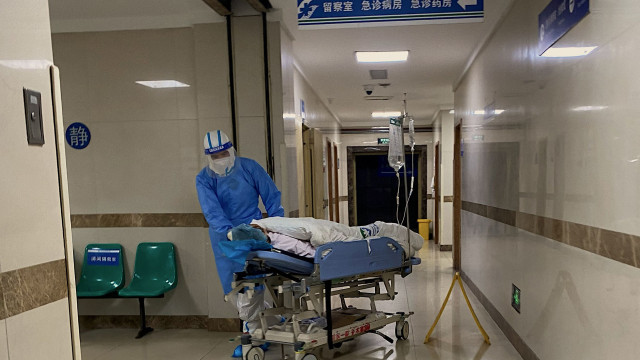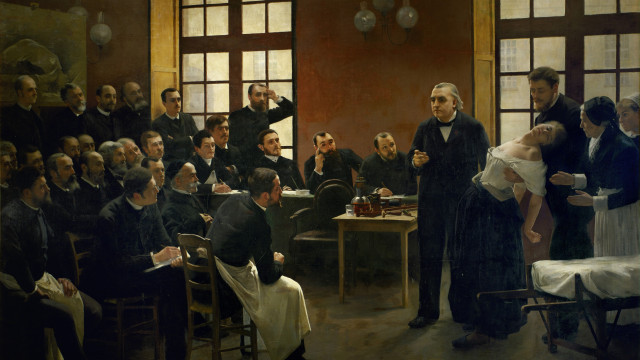





























See Also
See Again
© Shutterstock
0 / 30 Fotos
What is gastritis?
- Gastritis is an inflammation of the stomach lining. When the immune system detects a threat to this lining, it triggers an inflammatory response.
© Shutterstock
1 / 30 Fotos
Types of gastritis: acute gastritis
- There are a few types of gastritis, one of which occurs suddenly and its duration is temporary. This is called acute gastritis.
© Shutterstock
2 / 30 Fotos
Types of gastritis: chronic gastritis
- Chronic gastritis is when the condition is present over a long period of time. Symptoms may not manifest at all times and it’s usually linked to other chronic conditions.
© Shutterstock
3 / 30 Fotos
Types of gastritis: erosive
- In addition to the duration, gastritis can also be erosive or non-erosive. In the case of erosive gastritis, the lining of the stomach is actually left with injuries, including ulcers.
© Shutterstock
4 / 30 Fotos
Types of gastritis: non-erosive
- In the case of non-erosive gastritis, the stomach lining doesn’t get eroded as such but reddening and irritation are present. In the specific case of atrophic gastritis, the stomach lining gets thinner as a result of the inflammation.
© Shutterstock
5 / 30 Fotos
Other types of gastritis
- It’s also common for the condition to be named after the cause. Some examples include alcohol-induced gastritis, autoimmune gastritis, drug-induced gastritis, infectious gastritis, stress-induced gastritis, and eosinophilic gastritis.
© Shutterstock
6 / 30 Fotos
Signs and symptoms
- Sometimes noticeable symptoms may not be present, but later develop as the condition worsens. In the case of acute gastritis, however, they are a lot quicker to manifest. The most common symptoms include stomach pain, bloating, indigestion, loss of appetite, hiccups, nausea, and vomiting.
© Shutterstock
7 / 30 Fotos
Causes
- Gastritis may be caused by several things, including infections, chemicals, diseases, and lifestyle choices. Let’s take a look at the most common ones.
© Shutterstock
8 / 30 Fotos
Causes
- Alcohol and tobacco consumption, as well as overuse of NSAIDs (nonsteroidal anti-inflammatory drugs), such as aspirin and ibuprofen, are among the main causes of gastritis.
© Shutterstock
9 / 30 Fotos
Causes
- Bacterial and viral infections (e.g. stomach flu or H. pylori bacteria) are one of the main culprits when it comes to acute gastritis.
© Shutterstock
10 / 30 Fotos
Causes
- Autoimmune diseases can also trigger gastritis. Inflammatory conditions such as celiac disease, Crohn's disease, or sarcoidosis, can be the root cause of gastritis.
© Shutterstock
11 / 30 Fotos
Causes
- Other possible causes of gastritis include chemotherapy and radiation therapy, bile reflux, and psychological stress.
© Shutterstock
12 / 30 Fotos
Diagnosis: blood tests
- In addition to a physical examination and review of medical history, healthcare providers may prescribe a number of tests, including blood work to screen for anemia and infections.
© Shutterstock
13 / 30 Fotos
Diagnosis: imaging tests
- To diagnose gastritis, an upper gastrointestinal (GI) series, which are x-rays of the upper GI tract, are usually performed to detect ulcers and damage to the stomach.
© Shutterstock
14 / 30 Fotos
Diagnosis: endoscopy
- An upper endoscopy is sometimes required to diagnose gastritis, and in some cases, a biopsy of the stomach lining tissue is performed at the same time.
© Shutterstock
15 / 30 Fotos
Diagnosis: test for H. pylori
- A test for the H. pylori bacteria can also be performed. A breathing test is sometimes done, which involves swallowing urea and then breathing into a bag. Excessive levels of dioxide carbon will indicate the presence of a bacterial infection.
© Shutterstock
16 / 30 Fotos
Treatment
- Treatment of gastritis will depend on the cause. In the case of alcohol or drugs such as NSAIDs, cessation (under medical supervision) is recommended.
© Shutterstock
17 / 30 Fotos
Treatment: antacids
- There are however a few treatments that are helpful in managing the condition. One of them is the use of antacids. These can be bought over the counter and help neutralize excessive acid in the stomach.
© Shutterstock
18 / 30 Fotos
Treatment: H2 blockers and proton pump inhibitors
- Histamine-blocker (H2) medication helps reduce the amount of acid produced by the stomach, which can be helpful when dealing with an inflamed stomach lining. Proton pump inhibitors, which work in a similar way, are also used to treat gastritis.
© Shutterstock
19 / 30 Fotos
Treatment: surface coating agents
- Surface coating agents are particularly helpful when there is damage to the stomach lining. These protect the stomach from acid and enzymes, allowing the damage to heal.
© Shutterstock
20 / 30 Fotos
Other treatments
- In the case of a bacterial infection (i.e. H. pylori), antibiotics are prescribed. Healthcare providers may also recommend anti-nausea medications if it’s a symptom.
© Shutterstock
21 / 30 Fotos
Possible complications: peptic ulcers
- A number of complications can arise from gastritis, being one of them peptic ulcers. These sores can bleed and cause pain in the stomach.
© Shutterstock
22 / 30 Fotos
Possible complications: gastrointestinal perforation
- An ulcer in advanced stages can perforate the wall of the stomach, which in turn can lead to peritonitis, which is an inflammation of the abdominal cavity.
© Shutterstock
23 / 30 Fotos
Possible complications: gastric outlet obstruction
- Long-term inflammation can lead to scar tissue from ulcers to form. This can gradually block the opening between the stomach and the intestine, which can cause pain, nausea, and even vomiting.
© Shutterstock
24 / 30 Fotos
Possible complications: anemia
- Bleeding ulcers, H. pylori infection, and autoimmune gastritis can all interfere with vitamin B12 absorption, which may lead to pernicious anemia.
© Shutterstock
25 / 30 Fotos
Possible complications: atrophic gastritis
- Atrophic gastritis occurs when there is a thinning of the mucus layer in the stomach lining. This affects nutrient absorption and may lead to deficiencies.
© Shutterstock
26 / 30 Fotos
Possible complications: atrophic gastritis
- Atrophic gastritis can also lead to achlorhydria or hypochlorhydria, which is when the stomach fails to make enough of specific stomach acids, which also hinders nutrient absorption. This type of gastritis can lead to stomach cancer.
© Shutterstock
27 / 30 Fotos
Prevention
- The only way to prevent gastritis is by maintaining good hygiene to prevent infections, and limiting the consumption of alcohol and foods that can irritate the stomach lining.
© Shutterstock
28 / 30 Fotos
Prevention
- Managing stress levels, avoiding smoking, and minimizing the use of NSAIDs can also help prevent gastritis. Sources: (Cleveland Clinic) (WebMD) (Mayo Clinic) See also: Restless legs syndrome: its symptoms, causes, and treatment
© Shutterstock
29 / 30 Fotos
© Shutterstock
0 / 30 Fotos
What is gastritis?
- Gastritis is an inflammation of the stomach lining. When the immune system detects a threat to this lining, it triggers an inflammatory response.
© Shutterstock
1 / 30 Fotos
Types of gastritis: acute gastritis
- There are a few types of gastritis, one of which occurs suddenly and its duration is temporary. This is called acute gastritis.
© Shutterstock
2 / 30 Fotos
Types of gastritis: chronic gastritis
- Chronic gastritis is when the condition is present over a long period of time. Symptoms may not manifest at all times and it’s usually linked to other chronic conditions.
© Shutterstock
3 / 30 Fotos
Types of gastritis: erosive
- In addition to the duration, gastritis can also be erosive or non-erosive. In the case of erosive gastritis, the lining of the stomach is actually left with injuries, including ulcers.
© Shutterstock
4 / 30 Fotos
Types of gastritis: non-erosive
- In the case of non-erosive gastritis, the stomach lining doesn’t get eroded as such but reddening and irritation are present. In the specific case of atrophic gastritis, the stomach lining gets thinner as a result of the inflammation.
© Shutterstock
5 / 30 Fotos
Other types of gastritis
- It’s also common for the condition to be named after the cause. Some examples include alcohol-induced gastritis, autoimmune gastritis, drug-induced gastritis, infectious gastritis, stress-induced gastritis, and eosinophilic gastritis.
© Shutterstock
6 / 30 Fotos
Signs and symptoms
- Sometimes noticeable symptoms may not be present, but later develop as the condition worsens. In the case of acute gastritis, however, they are a lot quicker to manifest. The most common symptoms include stomach pain, bloating, indigestion, loss of appetite, hiccups, nausea, and vomiting.
© Shutterstock
7 / 30 Fotos
Causes
- Gastritis may be caused by several things, including infections, chemicals, diseases, and lifestyle choices. Let’s take a look at the most common ones.
© Shutterstock
8 / 30 Fotos
Causes
- Alcohol and tobacco consumption, as well as overuse of NSAIDs (nonsteroidal anti-inflammatory drugs), such as aspirin and ibuprofen, are among the main causes of gastritis.
© Shutterstock
9 / 30 Fotos
Causes
- Bacterial and viral infections (e.g. stomach flu or H. pylori bacteria) are one of the main culprits when it comes to acute gastritis.
© Shutterstock
10 / 30 Fotos
Causes
- Autoimmune diseases can also trigger gastritis. Inflammatory conditions such as celiac disease, Crohn's disease, or sarcoidosis, can be the root cause of gastritis.
© Shutterstock
11 / 30 Fotos
Causes
- Other possible causes of gastritis include chemotherapy and radiation therapy, bile reflux, and psychological stress.
© Shutterstock
12 / 30 Fotos
Diagnosis: blood tests
- In addition to a physical examination and review of medical history, healthcare providers may prescribe a number of tests, including blood work to screen for anemia and infections.
© Shutterstock
13 / 30 Fotos
Diagnosis: imaging tests
- To diagnose gastritis, an upper gastrointestinal (GI) series, which are x-rays of the upper GI tract, are usually performed to detect ulcers and damage to the stomach.
© Shutterstock
14 / 30 Fotos
Diagnosis: endoscopy
- An upper endoscopy is sometimes required to diagnose gastritis, and in some cases, a biopsy of the stomach lining tissue is performed at the same time.
© Shutterstock
15 / 30 Fotos
Diagnosis: test for H. pylori
- A test for the H. pylori bacteria can also be performed. A breathing test is sometimes done, which involves swallowing urea and then breathing into a bag. Excessive levels of dioxide carbon will indicate the presence of a bacterial infection.
© Shutterstock
16 / 30 Fotos
Treatment
- Treatment of gastritis will depend on the cause. In the case of alcohol or drugs such as NSAIDs, cessation (under medical supervision) is recommended.
© Shutterstock
17 / 30 Fotos
Treatment: antacids
- There are however a few treatments that are helpful in managing the condition. One of them is the use of antacids. These can be bought over the counter and help neutralize excessive acid in the stomach.
© Shutterstock
18 / 30 Fotos
Treatment: H2 blockers and proton pump inhibitors
- Histamine-blocker (H2) medication helps reduce the amount of acid produced by the stomach, which can be helpful when dealing with an inflamed stomach lining. Proton pump inhibitors, which work in a similar way, are also used to treat gastritis.
© Shutterstock
19 / 30 Fotos
Treatment: surface coating agents
- Surface coating agents are particularly helpful when there is damage to the stomach lining. These protect the stomach from acid and enzymes, allowing the damage to heal.
© Shutterstock
20 / 30 Fotos
Other treatments
- In the case of a bacterial infection (i.e. H. pylori), antibiotics are prescribed. Healthcare providers may also recommend anti-nausea medications if it’s a symptom.
© Shutterstock
21 / 30 Fotos
Possible complications: peptic ulcers
- A number of complications can arise from gastritis, being one of them peptic ulcers. These sores can bleed and cause pain in the stomach.
© Shutterstock
22 / 30 Fotos
Possible complications: gastrointestinal perforation
- An ulcer in advanced stages can perforate the wall of the stomach, which in turn can lead to peritonitis, which is an inflammation of the abdominal cavity.
© Shutterstock
23 / 30 Fotos
Possible complications: gastric outlet obstruction
- Long-term inflammation can lead to scar tissue from ulcers to form. This can gradually block the opening between the stomach and the intestine, which can cause pain, nausea, and even vomiting.
© Shutterstock
24 / 30 Fotos
Possible complications: anemia
- Bleeding ulcers, H. pylori infection, and autoimmune gastritis can all interfere with vitamin B12 absorption, which may lead to pernicious anemia.
© Shutterstock
25 / 30 Fotos
Possible complications: atrophic gastritis
- Atrophic gastritis occurs when there is a thinning of the mucus layer in the stomach lining. This affects nutrient absorption and may lead to deficiencies.
© Shutterstock
26 / 30 Fotos
Possible complications: atrophic gastritis
- Atrophic gastritis can also lead to achlorhydria or hypochlorhydria, which is when the stomach fails to make enough of specific stomach acids, which also hinders nutrient absorption. This type of gastritis can lead to stomach cancer.
© Shutterstock
27 / 30 Fotos
Prevention
- The only way to prevent gastritis is by maintaining good hygiene to prevent infections, and limiting the consumption of alcohol and foods that can irritate the stomach lining.
© Shutterstock
28 / 30 Fotos
Prevention
- Managing stress levels, avoiding smoking, and minimizing the use of NSAIDs can also help prevent gastritis. Sources: (Cleveland Clinic) (WebMD) (Mayo Clinic) See also: Restless legs syndrome: its symptoms, causes, and treatment
© Shutterstock
29 / 30 Fotos
Gastritis 101: symptoms, causes, and how to treat it
When having fire in your belly is not a good thing
© Shutterstock
Gastritis is an inflammation of the stomach lining that can affect people in different ways. It's a pretty common condition that affects millions around the world. In the US alone, 8 out of 1,000 people suffer from acute gastritis, which can be caused by excessive alcohol consumption or overuse of certain medications. When it comes to the chronic version of the condition, it's estimated that about 2 in 10,000 Americans suffer from it, and the number is believed to be a lot higher worldwide.
In this gallery you'll get to know all about gastritis; from causes to symptoms, and treatment. Click on.
RECOMMENDED FOR YOU






























MOST READ
- Last Hour
- Last Day
- Last Week








